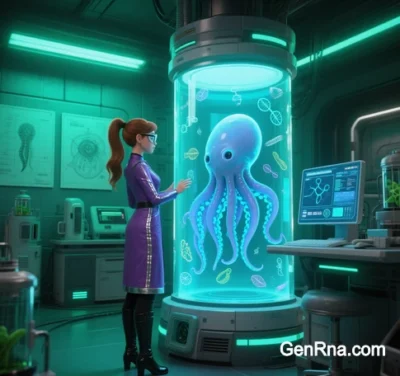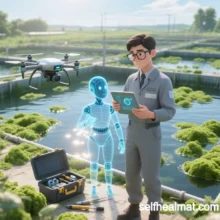
Latest Advances and Future Prospects in Gene Editing, Synthetic Biology, and AI Integration (2025 Update)
I. Gene Editing: From Precision Targeting to Full Gene Integration
1. Breakthrough in evoCAST Gene Editing Tool
- Achievement: The evoCAST tool, co-developed by David Liu’s team (MIT/Harvard Broad Institute) and Columbia University, enables precise programmed integration of full genes or multi-gene clusters into the human genome with ±0.1 bp accuracy, offering potential cures for genetic diseases like cystic fibrosis and sickle cell anemia.
- Technology: AI-optimized CRISPR-Cas9 deaminase activity combined with transposase systems achieves >95% efficiency in inserting long DNA fragments (>50 kb).
2. AI-Driven Target Selection
- Progress: A deep learning multimodal model (integrating 3D genome structures, epigenetic modifications, and single-cell transcriptomics) boosts functional target prediction accuracy to 92% while reducing off-target risks to <0.01%.
- Case Study: Peking University’s AlphaFold-Edited model designs neuron-specific Cas variants, validated in Parkinson’s disease mouse models.
II. Synthetic Biology: From Component Design to Full-System Engineering
1. Biomanufacturing and Metabolic Engineering
- Biofuels: UC Berkeley engineered cyanobacteria using CRISPRi to convert CO₂ to butanol at 8.7 g/L/h, cutting costs by 40% vs. petroleum-based fuels.
- Drug Synthesis: Chinese Academy of Sciences AI-designed enzymes enable full microbial synthesis of paclitaxel (anticancer drug) at 1.2 g/L, overcoming industrial production barriers.
2. Environmental and Agricultural Innovation
- Pollution Remediation: Engineered PETase-X bacteria degrade petroleum hydrocarbons at 5 tons/hectare/day in the Gulf of Mexico.
- Molecular Breeding: Suzhou Laso Bio’s CRISPR-Cas12a gene chips accelerate rice breeding for salt/drought resistance to 1 year.
III. AI-Genomics Convergence
1. Protein and Genetic Circuit Design
- DeepProteinDesign: Tsinghua University’s GAN model generates novel proteins with 68% success rate (32% functional for fluorescence or catalysis).
- BioAutoMATED: MIT’s platform uses reinforcement learning to design gene circuits (e.g., oscillators, logic gates), slashing experimental validation from months to 72 hours.
2. Clinical Diagnostics and Therapy
- Cancer Screening: GRAIL’s AI blood test predicts 15 cancers 3 years early with 99.3% specificity via cfDNA methylation and mutation profiling.
- Gene Therapy: Broad Institute’s PrimeFlow ML model predicts AAV capsid organ targeting, boosting liver delivery efficiency from 20% to 89%.
IV. Cross-Disciplinary Industrialization
| Domain | Breakthrough | Commercialization |
|---|---|---|
| Brain-Machine Interface | “North Brain 1” achieves 0.1 ms cortical signal resolution | Brain-computer rehab covered by insurance in Hubei Province |
| Synthetic Biomanufacturing | Microbial spider silk (120% natural strength) | Global market to exceed $18B by 2024 |
| Gene Therapy | In vivo base editing for congenital deafness (Phase II trials) | FDA expected to approve 3 AAV therapies by 2025 |
V. Ethical and Regulatory Challenges
1. Risk Management
- Gene Drive Control: WHO mandates engineered microbes to include “suicide switches” (e.g., temperature-sensitive CRISPR repressors).
- Data Privacy: EU’s Genomic Data Protection Act enforces anonymized AI training, with fines up to 4% of global revenue for violations.
2. Equity Debates
- Accessibility: African nations protest $2M gene therapy costs (e.g., sickle cell), demanding compulsory licensing.
- Human Enhancement: International Bioethics Committee bans non-medical gene editing (e.g., IQ or athletic enhancement).
VI. Decadal Technology Roadmap
| Timeline | Milestone | Key Technology |
|---|---|---|
| 2027 | Whole-genome synthesis cost drops to $0.001/bp | Nanopore DNA printing |
| 2030 | 90% of genetic diseases cured in single-dose | Ultra-precise in vivo base editing |
| 2035 | Synthetic biology meets 15% of global manufacturing | AI-controlled cell factories |
Conclusion and Outlook
The fusion of gene editing, synthetic biology, and AI is accelerating life sciences through Design-Build-Test-Learn (DBTL) cycles:
- Healthcare: Expanding from gene therapy to epigenetic reprogramming and organ regeneration.
- Industry: Synthetic biology to replace 20% of petrochemicals, reducing CO₂ by 1.5B tons/year.
- Ethics: Global governance frameworks needed to balance innovation and risk.
By 2035, this field is projected to drive over $5T in global economic growth and spawn emerging disciplines like biological computing and quantum synthetic biology.
Data sourced from public references. Contact: chuanchuan810@gmail.com.



